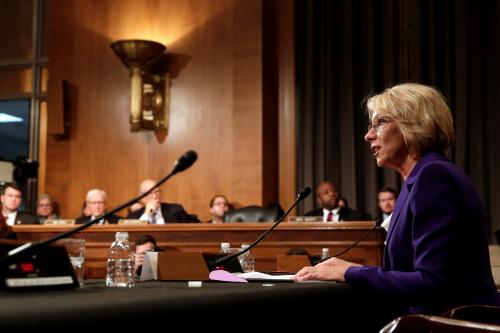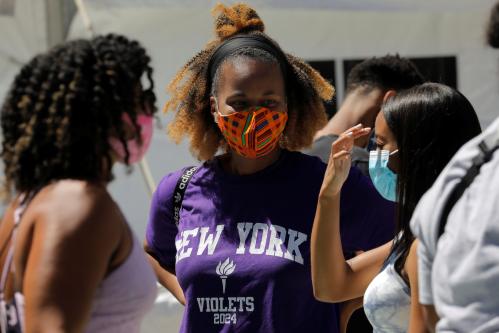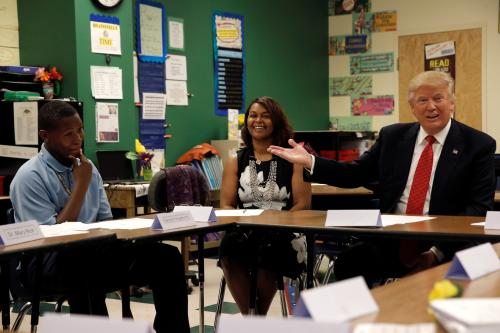On a Friday in mid-August, Education Secretary Betsy DeVos quietly announced that she would abolish the Obama administration’s gainful employment (GE) regulation–a safeguard that protected students from for-profit career programs that left graduates with poor job prospects and unmanageable student debt.
Her decision means that hundreds of thousands of our nation’s students–chiefly minority students, single moms, veterans, dislocated workers, and working adults–will now be trapped in low-performing for-profit programs and burdened with unaffordable and often life-limiting debts. Her regulatory rollback marks a betrayal not only of our nation’s most vulnerable students, but an abandonment of traditional conservative principles about institutional accountability for taxpayer dollars.
In “Betsy DeVos and her cone of silence on for-profit colleges,” we detail both the surprising historical context and real-world implications of Secretary DeVos’s flight from accountability.
Accountability abandoned: Secretary DeVos’s federal free-money plan
To see just how extreme Secretary DeVos’s departure is from conservative principles, we ask this litmus test question: What would it take for a career education program to lose its eligibility for federal student aid under Secretary DeVos’s plan? The answer: A for-profit institution cannot lose its financial lifeline, no matter how poorly it performs its statutory mission to train students for gainful employment in a recognized occupation. One hundred percent of students can drop out of their career program, or not a single graduate could land a job in their field of training, and still the federal government would be willing to keep the taxpayer money pipeline of federal student loans and Pell Grants flowing unabated to the school. It’s a federal free-money plan—“accountability” stripped of consequences.
DeVos argues that cutting off federal aid to low-performing programs might ensnare some worthwhile programs, reducing career-training options for minority students and students with few local alternatives. She also argues that it is unfair to hold career programs accountable for saddling students with unmanageable debt because traditional college non-career programs are not held to the same standard.
Yet DeVos’s abandonment of federal accountability for program outcomes like unfettered student debt stands in marked contrast to nearly all of her Republican predecessors. In the latter half of the 1980s, student default rates and government dependency soared at for-profit institutions as news reports and federal and state investigations documented widespread recruiting abuses. In response, Ronald Reagan’s secretary of education, Bill Bennett, proposed new regulations under which more than 2,000 postsecondary institutions would immediately face a hearing to limit, suspend, or terminate their participation in federal student aid programs if their default rate on federal loans exceeded 20 percent. Bennett blasted shoddy trade school programs, stating that the “pattern of abuses” documented in a department-sponsored investigation was “an outrage perpetrated not only on the American taxpayer but most tragically upon some of the most disadvantaged and most vulnerable members of society.”
In 1992, with the support of then-Education Secretary Lamar Alexander, Congress passed the 1992 amendments to the Higher Education Act (HEA), under which postsecondary institutions lost their eligibility for federal student aid if their student default rates exceeded 25 percent for three consecutive years. By 2000, more than 1,000 postsecondary institutions lost their federal student eligibility under the 25 percent default rate cut-off restriction. Just as Secretary Bennett had predicted, more than 80 percent of those institutions, nearly 850 schools, were for-profit schools.
DeVos and Alexander’s faux equity arguments—and the myth of the regulatory level playing field
In contrast to his views during his time as secretary of education, Sen. Alexander now echoes Secretary DeVos’s rhetoric calling for uniform regulation of all higher education institutions. At first glance, the DeVos-Alexander position appears to establish a uniform standard of institutional equity and fairness on the part of the federal government. But for two reasons, the universal standards argument is much less compelling than it seems.
For starters, it is impossible to regulate all institutions of higher education identically, barring a massive overhaul of federal law. Several federal agencies have laws and regulatory authority applicable to for-profit educational enterprises (e.g., statutes outlawing false advertising, protecting competition in interstate markets, consumer protection laws, etc.) that do not exist with respect to nonprofit institutions of higher education. Conversely, federal and state laws allow for-profit educational institutions to operate under less restrictive investment and accountability requirements than nonprofit institutions in a number of critical areas. While nonprofit and public colleges are generally required to reinvest any funds that remain after paying institutional expenses for educational or charitable purposes, the owners of for-profit colleges are expected to earn and maximize profits.
The second problem with regulating all postsecondary institutions uniformly stems from lawmakers’ beliefs as to whether very different types of colleges should always and only be judged by the same standards. For-profit programs have very different missions than traditional liberal arts colleges and research universities. While for-profit programs are required by federal law to train students for “gainful employment” in a specific job field to qualify for federal student aid, liberal arts colleges and research universities focus on teaching students to “think critically,” develop civic skills, and typically do not provide direct vocational training.
Behind the Republican flip-flop on for-profits: Follow the money, and the conspiracy theories
When a political party reverses its longstanding position on an issue, the obvious question is why.
The first and most important cause of the Republican retreat from accountability is the growing power of the for-profit college lobby. By 2005, the eight largest for-profit college chains had a combined market value of $26 billion. For-profit colleges, which always had aggressive lobbying operations, started donating much more money to congressional representatives and switched more of their giving from Democrats to Republican lawmakers. When the Obama administration released its final GE rule, the for-profit lobby donated twice as much to Republican lawmakers ($1.17 million) as to Democratic lawmakers ($583,000).
Conservatives also developed conspiracy theories about the Obama administration’s motives for proposing the GE rule to dismiss the need for regulation of the for-profit sector. Despite an abundance of evidence to the contrary, GOP lawmakers and presidential candidates, conservative pundits, and for-profit lobbyists hewed to the fanciful claim that the GE rule stemmed from President Obama’s personal animus against profit-making colleges and his purported contempt for capitalism itself.
The GOP’s rhetoric about the Obama administration’s “ideological war” against profit-making colleges had two damaging long-term consequences. First, it became taboo for Republicans not only to acknowledge widespread abuses in the for-profit sector, but also to publicly discuss policy solutions to address the sector’s shortcomings. As a consequence of the GOP’s self-imposed “cone of silence,” Republican policymaking on the for-profit sector has largely been taken over by the for-profit sector itself. At the Department of Education, Secretary DeVos appointed key executives and lobbyists from the for-profit sector to oversee investigations of for-profit schools and to help rewrite regulations affecting for-profit schools, including the GE rule–a textbook case of what economists refer to as “regulatory capture.”
It is difficult to identify a single sentence in the 88-page August 2018 notice of proposed rulemaking (NPRM) rescinding the GE rule to which an industry representative might object. The NPRM is especially notable for its painfully thin and seemingly predetermined use of “research-based” evidence. The authors of two research papers cited by Secretary DeVos as evidence for the repeal of the rule, Sandy Baum and Nicholas Hillman, have released statements saying the department misinterpreted and misrepresented their research. And even after 20 months in office, Secretary DeVos took to repeating false industry talking points about the GE rule—most notably the erroneous claim that the GE rule applied to institutions based simply on their tax status.
The inexorable cycle of for-profit regulation: It’s déjà vu all over again
One of the authors of the report, David Whitman, has documented that the regulatory chronology of for-profit schools has repeatedly followed the same cycle since the 1944 enactment of the landmark GI Bill of Rights. That cycle can be summarized as follows: Initially, generous federal student aid programs, with few strings attached, spawn dramatic growth in for-profit schools; rapid growth in the for-profit sector then leads to institutional abuses of students, government aid programs, and media exposés; then the scandals and abuses subsequently prompt Congress and the administration to adopt regulatory and legislative reforms that force the for-profit sector to retrench. Within a few years, as the worst abuses fade and industry leaders promise that the abuses of the bad old days will never return, federal agencies and Congress ease restrictions on federal monies for for-profit schools–and the cycle begins anew.
The for-profit regulatory cycle exists for good reason–namely because it is driven by the laws of economics and human behavior. When government provides businesses with an opportunity to procure a substantial pot of government money to educate people for careers with few strings attached, profit-making businesses and enterprising business owners will make the most of the opportunity. Not all or even most for-profit programs shortchange students. But it is an inescapable truth of history that for-profit colleges face and often succumb to perverse financial incentives to boost profits by cutting corners in educating students.
Secretary DeVos argues that her plan to require all colleges to publish more detailed information by program on post-graduation earnings, debt, and other outcome measures on college-related websites would “inform student enrollment decisions through a market-based accountability system.” However, history and a rich body of research shows that transparency alone, in the absence of meaningful sanctions, is ineffective. The consequence is that hundreds of low-performing for-profit programs will resume gorging on taxpayer dollars, while they load up disadvantaged students with loan debt and worthless degrees.
The for-profit college cult of victimization—and its real victims, students and taxpayers
The conservative narrative that for-profit colleges were the hapless victims of an ideological war by the Obama administration ignored the real victims—students and taxpayers. Ultimately, the most tragic consequence of Secretary DeVos’s abandonment of federal accountability is the devastating personal toll it will take on hundreds of thousands of hopelessly indebted students.
The Trump administration projects that the elimination of the GE rule will cost taxpayers $5.3 billion in student loans and Pell Grants over the next decade, almost all of which will now go into the coffers of poorly performing for-profit programs. Even worse, the repeal of the regulation will trap more than 350,000 students deep in debt in the nation’s worst-performing career education programs. It is doubly unfair that many of the victims of low-performing career programs are not just economically disadvantaged, but are single parents who are doing all the right things to better their careers and improve the lives of their children.
Early in her tenure, Secretary DeVos pledged, “Every decision I make as a secretary of education is considered through a single, focused lens: How does this affect an individual student? When a program isn’t working in the best interests of [college] students, I fight to change it.” In every respect, her decision to eliminate the GE rule violates that worthy pledge. There is no evidence that any students asked Secretary DeVos to eliminate sanctions on ineffective career programs, programs that today are little more than debt traps for students.
Secretary DeVos’s repeal of the GE regulation shows the Trump administration has the backs of CEOs of for-profit colleges, but has abandoned protecting the single moms, veterans, minority students, dislocated workers, and other working adults who enrolled in subpar career programs on the promise of landing a better job and leading a better life.
Secretary DeVos stood up for for-profit executives, but sadly not for vulnerable students.







Commentary
Betsy DeVos puts protecting for-profit schools ahead of students
October 17, 2018